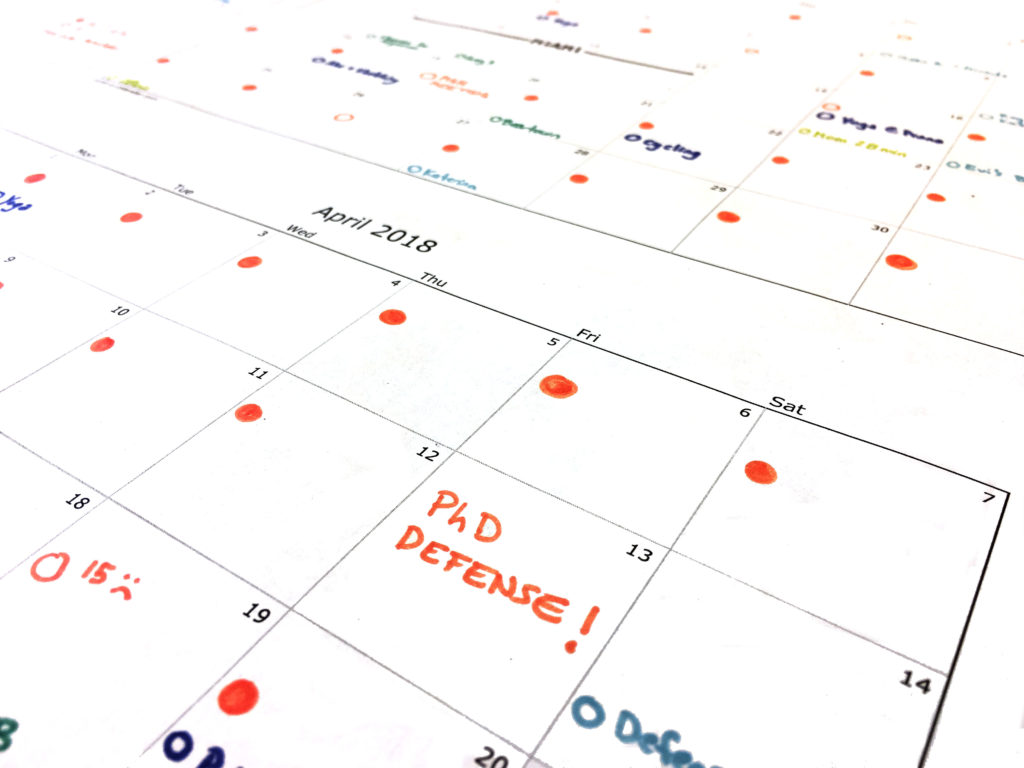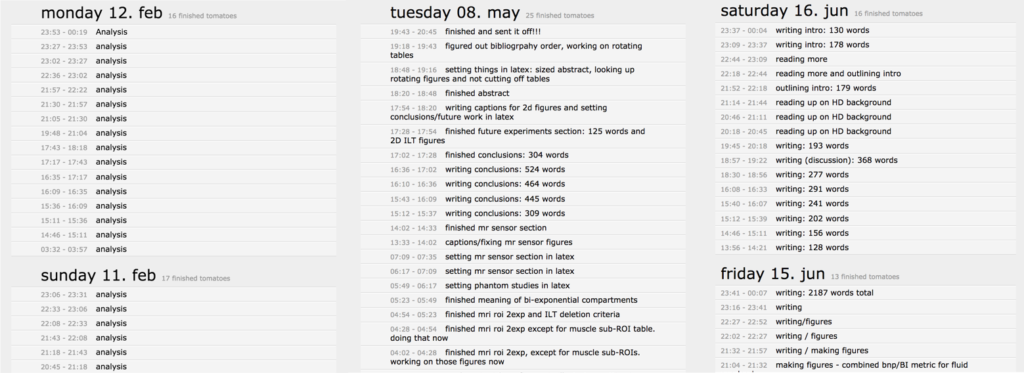I finished my PhD in Biomedical Engineering at a joint program between MIT and Harvard Medical School. During the last 9 months of my PhD, my life could be summarized by: work, eat, sleep, and repeat. There were times where I didn’t leave my apartment for days on end. It was a brutal schedule.
I want to write about the work systems I developed during this period of time and how they can be applied to your own life.
The Tomato Method: The Basics
The Tomato Method is based around the Pomodoro Method, which consists of 25 minutes of work followed by a 5-minute break. I used a website called mytomatoes.com that (1) counts down these 25 minute increments, (2) asks you to write down what you did in those 25 minutes at the end of the time block, and then (3) records your answers so you have a log of how you have used your time.

The website mytomatoes.com tracks the number of “tomatoes” (25-minute increments of focused work) you do per day.
My goal was to get 16 “tomatoes” per day recorded on mytomatoes.com. When I got 16+ tomatoes per day, I put a solid red circle on a calendar that I had hanging next to my desk. When I got 10-15 tomatoes per day, I put an empty red circle on the calendar. If I got <10 tomatoes, I put nothing on the calendar.

When I achieve 16+ tomatoes in the day, I put a solid red circle on my calendar. When I achieve 10-15 tomatoes in the day, I put an empty red circle on the calendar. This allows me to easily track my work schedule and productivity over time.
The golden rule of this method is that the 25-minute tomato has to consist of pure work. If you find yourself going on Facebook or someone comes to chat with you or your work gets interrupted for whatever reason, you must “squash” the tomato and start over.

The golden rule of the “Tomato Method” is that the 25-minutes must consist of pure work. If you get distracted or interrupted for whatever reason, you must “squash” the tomato and start over. Most people are surprised by how often these little interruptions come when they start tracking it.
A few final details:
- I almost always skipped the 5-min breaks and just refreshed the page to start a new tomato.
- The tomato count for the day resets at midnight so you must get all your tomatoes done before midnight [1]
- I usually did not count emails as work, except in rare cases where I had a pile-up of emails that I absolutely needed to respond to and had been avoiding
- I usually counted research meetings as 1 tomato regardless of how long the meeting took. Sometimes I did not count meetings as work.
The Rationale and How to Apply It
The hardest thing about a PhD is knowing how much to work and keeping yourself accountable to that schedule. Imagine waking up every day for 5+ years and needing to decide what to do, when to do it, how to do it… and then making sure you do it.
At the beginning of my PhD, I relied of inspiration. I would sit in lab and do emails or other non-important work, and, consequently, not accomplish much real research. Then a deadline would approach and I pulled all-nighters to meet it. After the deadline, I would be exhausted and un-motivated and the cycle would repeat [2].
Setting a target tomato goal helped me focus my day when there was no other structure.
“Do I have time to go this cool talk?” Well it’s 7pm and I still have 10 more tomatoes to do before midnight. If I go to the talk, I won’t be able to finish my tomatoes. So no, I can’t go.
“Do I have time to go get coffee with my colleagues?” I have 2.5 hours before I need to leave the office and just 3 more tomatoes left. So yes, I can take this break now.
There were days where each tomato was excruciatingly painful. I could barely sit through one 25-minute session. There were other days where the tomatoes flew by.
The key is setting the right tomato goal.
16 tomatoes per day is a ruthless schedule. Researchers have estimated that out of a standard 8-hour workday, most people only actually do real work for 3 hours. Doing 7 hours (16 tomatoes) of focused deep work usually took the whole day to accomplish. I would not recommend 16 tomatoes per day unless you need to be pushing really hard (i.e. to finish a thesis or prepare for an upcoming conference).
A reasonable work-load if you’re on a maker-schedule is 10 tomatoes per day [3-4].
If you have multiple meetings or classes per day, 4-5 tomatoes might be reasonable. About 2 hours of true focused work per day is honestly more than most people achieve.
Summary
If you are a PhD student or are building a startup or have other work with few external deadlines…
• Use the Tomato Method every day and track the days you achieve your tomato goal on a calendar.
What matters is the consistency with which you achieve your tomato goal, not the absolute number of tomatoes. Writing what you’ve accomplished at the end of each 25-minutes also keeps you aware of when you are spending too long on certain tasks (i.e. it alerted me to when I had gone into the black hole of reading papers to find the answer to an insignificant question.)
If your life consists of a lot of meetings or classes, but you still want to get deep (important, non-urgent [5]) work done…
• Institute one “no meeting day” per week and use the Tomato Method to add structure and accountability to your “free” day.
• Set a low tomato count per day (3-5 tomatoes) and do them first thing in the morning.
When there are too many weeks in a row where you haven’t achieved your tomato goal, it’s a sign you might not be focusing on the “important but not urgent” work and may need to make a change to your life.
When you use the Tomato Method, make sure to:
1. Pick the right tomato goal (picking a number that is too high will make the method unsustainable)
2. Use mytomatoes.com to track the tomatoes [6]
3. When you reach your goal for the day, record it on a calendar
4. Repeat
Let me know what you think of the Tomato Method! How did it work for you? What methods do you use to keep yourself accountable?

Sometimes I wrote detailed descriptions of what I did during each tomato and sometimes I didn’t. When writing my thesis, I would record the word count I achieved during each tomato. Especially when writing, it is easy to let time pass by without actually writing words on the page.
Footnotes
[1] The tomatoes resetting at midnight was important for me because otherwise I would inevitably switch to a nocturnal schedule. This might not be as important of a feature for other people.
[2] Like many things in life, the PhD is a marathon not a sprint. Your “average speed” and not your peak speed is what matters. Read this fantastic article by James Clear on how to think about your average speed in all areas of life: https://jamesclear.com/average-speed
[3] If you haven’t already, definitely read Paul Graham’s legendary “Maker vs Manager Schedule” essay: http://www.paulgraham.com/makersschedule.html
[4] Personally, I think an ideal work-load for a PhD student in the middle of their degree is 10 (non-email, non-meeting) tomatoes per day with 2 days off per week. The numbers might look different if you need to do a lot of experiments as it is harder to track tomatoes when you are busy away from your computer or phone.
[5] If you haven’t already, read about the Eisenhower Matrix of important vs urgent work: https://jamesclear.com/eisenhower-box
[6] I am sure there are better Pomodoro-tracking websites than mytomatoes.com. One of the beauties of mytomatoes.com is how basic the site is. You can’t cheat it. You can’t edit your tomatoes after the fact (which can be infuriating when you have done 2hrs of work but forget to start a new tomato). The site doesn’t lie.
Thank you’s
Thank you to Sidney Primas for co-developing and implementing the Tomato Method with me as we both worked hard to finish our theses.










14 Responses to “The Tomato Method: How I Finished My PhD at MIT”
Nice! check out the forest app utilizing the pomodoro technique
I use the Pomodoro timer in my laptop all the time… such a good way to get things done and be realistic about the actual time we doing productive work. Thanks for sharing your insights! & congrats on the PhD, such a milestone!!!
I just started using my tomatoes a few months ago and it is amazing! Congrats on your PhD. 🙂
Thanks so much! And glad you like it!
Thanks,really helpfull.
As someone in the last months of their PhD, thank you so much for this article.
I was already using the Pomodoro method, but framing it with a daily target goal, some flexibility (i.e. 16 tomatoes is best but 10 or more is alright) was what I needed to make it work efficiently.
Thank you for the article! I guess the tomato method sounds way better than pomodoro method. By the way, you have excellent writing skills.
Seems like the security certificate has expired yesterday. I am heartbroken. I have been keeping track of my work on the site for 12 years 🙁